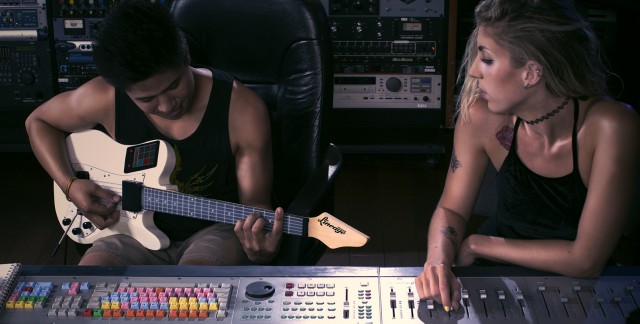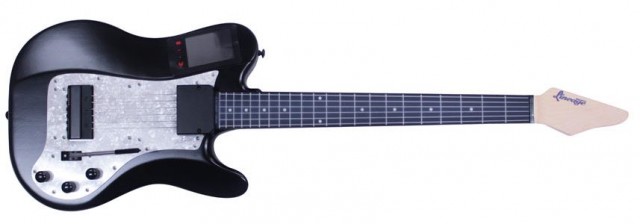
Inspired Instruments has introduced the Lineage MIDI Guitar = a new plug-and-play MIDI guitar instrument..

The Lineage MIDI Guitar controller features an LCD touch screen on the body, opening up easy access to a slew of mappable controllers and settings. The instrument is compatible with all MIDI capable software and hardware synthesizers. According to the developers, Lineage is virtually latency free, boasting similar speeds to that of a keyboard at 2-5ms.
Here’s a video performance demo:
In the video, Jeremie Revel uses a prototype of the Lineage MIDI Guitar, Launch Pad, and Ableton Live

The Lineage is crafted from real wood and is supported by other durable materials. The full-size body has a vintage shape and includes a 2.5mm pearlized pickguard and a 3.5in LCD touch screen. The maple neck is 1-11/16” measured at the nut and sports a traditional ‘C’ style contour with a 13” radius. The black and white standard scale 22 fret RADIUS fingerboard has simulated strings, providing the user with the familiarity of a guitar. The instrument uses enhanced YRG trigger system technology for the six stainless steel strings on the body with adjustable tension.
Control attributes include a full range whammy with an assignable whammy thumb button, volume knobs and assignable continuous controllers. The LCD offers additional assignable faders, pads, and an XY controller. The I/O panel includes a USB type B interface, MIDI 5-pin connector, a ¼” mono guitar out jack, stereo mini headphone/line output, and power switch. The Lineage has a rechargeable 4000 mAh lithium polymer battery for 10 hours of uninterrupted performance.
The Lineage also provides customizable parameter adjustments for individual playing styles—from traditional strum and finger picking styles to tap and MIDI monophonic modes. Additional parameters allow adjustment for customized layers mapped onto user-defined zones, open tunings, whammy-bar range, slide range, and MIDI velocity mapping. Equipped with a standard USB MIDI class driver, it is compatible with Mac, Windows, Linux and iOS operating systems. The Lineage interfaces with computers and tablets running DAWS, recording applications, tablature software, MIDI hardware and software synthesizers, or keyboards using either the USB or legacy 5-pin MIDI connectors.
The Lineage MIDI Guitar is available to pre-order now for US $999 and is expected to ship in Q3/Q4. See the Lineage Guitar site for details

Why!?
So guitar players don’t have to use keyboards to control midi instruments? Thought that would be pretty clear?
Looks like a nice instrument. That demo doesn’t show how dynamic it is, i.e., how well it responds to loud & soft playing. It is impressive how well it tracked fast tap-style (LH only) playing.
And for what it does, I don’t think a grand is asking too much. However, it doesn’t appear to “double as a guitar”. Because of how it works, perhaps a plain old guitar output isn’t possible.
Still, pretty interesting.
No headstock, strings tension has nothing to do with pitch on the strings. So it truly is a controller; not a guitar with MIDI pickups. I imagine that it detects fret contact point and measures tension change for bends. That would explain that thing at around 24th fret covering the board.
This makes the low latency unsurprising, as it isn’t trying to do a high-speed pitch detect on a real string. (Which is actually like Heisenberg’s uncertainty principle. You need more time to get a more accurate pitch reading. If you want solid timing within a shorter time, then the pitch would be less accurate. This is why MIDI guitar pickups are problematic.) The other problem with midi pickups is getting the strings totally isolated from each other. Given a perfect per-string pickup, most guitarists would prefer a synth that doesn’t even bother mashing it through MIDI. (A synth that takes a single string with a real timbre as per-voice input would do important things that MIDI doesn’t do correctly. MIDI makes wrong assumptions about multiple instances of the same note, doesn’t capture the full microtonal detail of the strings, and can’t take a full timbre of a real string as the input that produces the pitch/amplitude/CC, etc.)
This looks a lot like the same setup that was used with the SynthAxe, way back when. As I recall, the SynthAxe had some kind of tension sensing scheme for the “left hand” strings, to pick up bends, but I can’t tell if such is present on this device. Again, as I recall (poorly), the hardware for sensing bends was expensive and glitchy. But guitar players gotta *bend*, man!
As soon as one of these MIDI guitar makers decide to develop something for lefty-guitar players will be the day they get my business. C’mon, people let’s be more accommodating!
Based on YRG technology. You mean You Rock Guitar technology? I tried one of those and the experience was less than inspiring and it certainly was not frustration free. I hope for the day when we have a good midi guitar solution. Whatever that would be…Right now it seems to be a pipe dream.
FWIW, the guy’s a solid guitarist, clearly influenced by Holdsworth, one of my all-time favourite guitarists. Oh, and he’s… 22, playing guitar since he was 3.
I can’t tell from the video, does this support string bending for vibrato or just from the whammy bar?
Wonder how it deals with open strings as part of a strummed chord? The MIDI guitars I’ve triied have all left the open strings playing and require manual muting of each string, making it hard to play chord progressons.
I am a guitarist first and foremost, and while I’m not highly technical, I know a lot of chords, and that knowledge, the ability to play something in E or G and just know all the chords is lost when I move to a keyboard, hence I play in C/Am on keys. Or I sit down and write out the note in a chord (that I know instinctively and usually don’t have to think about on guitar) and have to teach myself to switch from chord. To chord on keys. It’s a pain. Keyboards that transpose are a great help in this.